The day Carel went home forever
Nürburg, August 1, 1964, the scene of the popular German Grand Prix, which would be held the next day. Carel Godin de Beaufort was going to race his old but reliable Porsche 718-201. During qualifying he used chassis number 202 which he usually used for free practice. He already skipped a practice session in the morning to save both his Porsches. Carel never drove more than was necessary. By Dennis Drenthe.
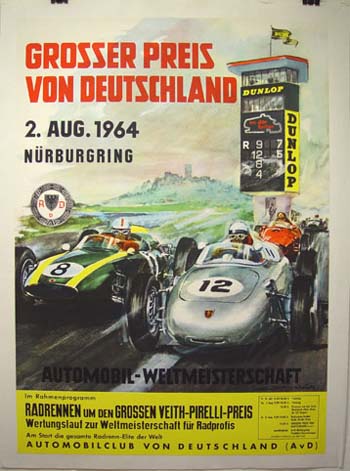
Carel's entry for the German Grand Prix had been accepted but that didn't mean he was guaranteed to start. In qualifying he needed to give everything and fight people like Pilette, Raby and Anderson. He set a time of 9.47, which was 10 seconds faster than a few years earlier when he was the first privateer to go under 10 minutes. But now he was slowest of them all.
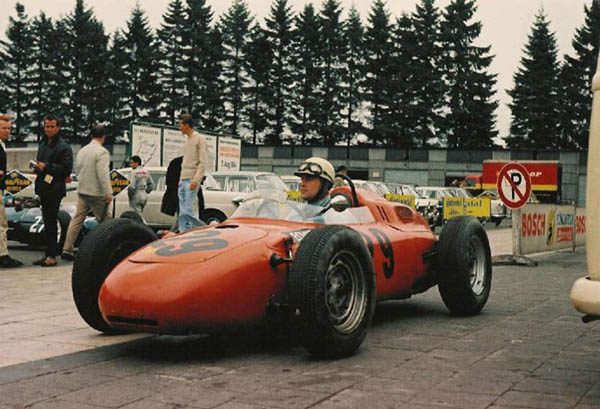
Going out for the last time.
Having saved some time and tyres early on, he really started to push on his fourth lap. He knew the 'Ring perfectly. Every corner, all the up-hill and down-hill sections, every detail. He was among the people with a natural talent to drive fast at this 22km racetrack, even being a driving and racing instructor at this challenging track, just like some other great drivers of that time.

In the Karoussel.
His last lap
After passing the start and finish line Carel drove through the Dunlop Kurve before using all the handling capabilities of his Porsche to navigate through the twisty sections of Hatzenbach and Hocheichen. Over the jump at Quiddelbacher Höhe, into Flugplatz and full throttle until Schwedenkreuz. He would brake for Aremberg, go down-hill under the bridge and flat out again through the Fuchsröhre, a fast left and medium right, before braking for the S corner called Adenauer Forst. While pushing his car he must have been sideways at that point. A short almost-straight to Metzgesfeld followed, then it was up-hill, left and right, and down the hill again, braking for Kallenhard. A late turn-in because of a corner that is longer than it seems. Then all the way down through a fast left and right, braking for the blind but really fast and tight right-hand corner of 'Miss Hit Miss' and coming close to the hedges at the left, at the end of this corner.
He then had to brake hard and do some quick heel & toe downshifting, releasing the brake pedal a bit, steering to right before braking hard again into Wehrseifen, a hairpin going to the left. This is the slowest corner at the Nürburging. You can trailbrake and turn in quickly, or go on as long as you can on the right side of the track before turning in and hitting the apex. So although it is the slowest, it is also one of the most technical parts for a driver, as it has camber and the track is still going down-hill. It is also a great spot for small and light cars to overtake bigger and faster cars. Underdog Carel must have loved this section, with his phenomenal driving skills but slow car!

At Bergwerk. The water drain is still visible.
After Wehrseifen our Flying Dutchman saw Hotel Nürburgring and the left-hand corner/bridge called Breidscheid. This is the lowest part of the circuit, and Carel was halfway down the track at that point. But he couldn't slow down yet, since the short, but very steep section to Ex-Mühle followed. A narrow uphill right-hander demanded all the motion he threw into it at the moment he turned in. He needed every horsepower and every bit of torque the flat-4 engine could deliver. Most of the time the inside rear wheel was slipping and it took a while until his underpowered car made any speed on this uphill straight. Carel must have really pushed his car over here. This is one of the sections where his car must have been slower than the others with a lot of horsepower and torque. He also had some tricks for the section that followed. His goal was to gain speed here, as much as possible, no matter what. So after Ex-Mühle he drove full throttle through an easy left-hander. This is the corner where Lauda crashed in 1976. It's been called the Lauda Kurve since. Carel lost control after this corner while wanting to brake for Bergwerk. The old car suddenly slipped sideways and Carel lost control. Unfortunately, he and his car flew down the slope next to the track. They each hit a tree.

This is where the accident happened.
Some say he spun of a couple of yards ahead of that place, as Carel sometimes used the inside of Bergwerk corner. Using a water drain he was able to reduce understeer in this high-speed and early turn-in technique, making a perfect four-wheel drift to gain speed for the long uphill section of Kesselchen. This was his secret trick, and it led to Gerard van Lennep and some of his employees creating their version of the story. They also had a theory about the fact that the water drain had been filled with concrete during earlier construction work. But on pictures taken that day Carel wasn't using this particular water drain, and it was still intact.

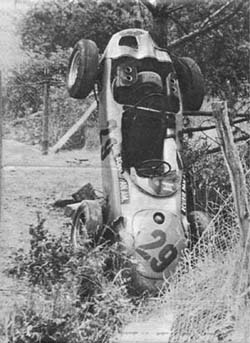
The remains of 718-202.
So after analysing this story and the place where Carel crashed, we searched and found a more reliable myth. Because one of the cars had leaked some oil or fuel in that fast left-hander, Carel's tyres on the right side lost their grip just at the moment he came out of the corner and started to brake for Bergwerk. His car pulled to the left and hit the bushes, flipping over, turning backwards and flying down the hill to land into a small tree, 10 metres below. Carel was thrown out of the car and landed behind the tree, having hit it first with his massive body. He was instantly paralysed, because he received a spinal cord injury at the moment of impact.
In hospital
Carel was taken to Koblenz hospital with serious internal injuries. In hospital doctors discovered a broken thighbone, a broken vertebra and very bad head injuries. The ambulance got stuck in traffic and there wasn't any specialist in hospital to help him. As soon as his mother heard the horrible news, she went to Koblenz with a family friend, professor Nuboer, a neurologist. On Sunday morning, his mother, Nuboer and (racing) friends like Ben Pon were told Carel was no longer in a life-threatening situation. He had been conscious for a while and had eaten something. Nuboer arranged a helicopter flight to get Carel to the neurological clinic at the University Hospital of Köln (Cologne). Doctors were fighting for his life until Carel Godin de Beaufort passed away at half past eleven that evening.
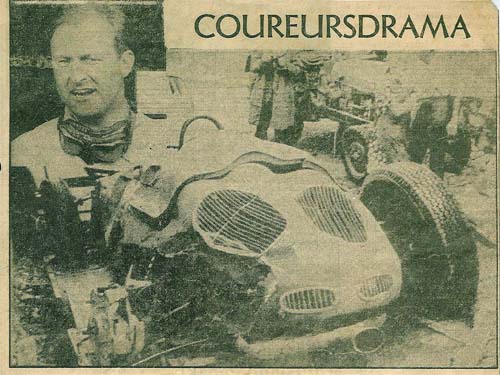

A clipping taken from the regional Limburg newspaper Maas- en Roerpost. It states that Carel was partially paralyzed but that his life is no longer in danger.
Formula One lost its last privateer while Holland lost its Veilige Careltje ('Safe Little Carel'). The Beaufort family lost their brave and endearing Carel and his warm sense of humour. His mother lost her son Karel, with his sweet soul and unstoppable energy. His sister lost her soulmate, who was one of her biggest friends, next to being a brother. Cornelie read the news in L’Équipe on Sunday morning while in Southern France. She phoned home but wasn't connected, so she went to Maarsbergen as quickly as she could. Her mother was still in Germany and grief-stricken, but showed great dignity. Louis and Sean Stanley from BRM went to see Carel in hospital, and Ben Pon wanted to go there too to visit Carel on Monday, still thinking his friend was alive and well.


There is a slightly different tune in the Maas- en Roerpost's next edition, now announcing Carel's death.
On November 6, Carel's funeral took place at the Maarsbergen Estate. For the funeral procession his coffin was placed on top of a white Porsche 356 convertible. Some of his motorsport friends walked besides it: Graham Hill, Bob Anderson, Herbert Linge, Wolfgang Seidel, Jan Dijkstra, Fritz Hüschke von Hanstein, Ben Pon, Gerhard Mitter, Gerhard Koch, Richard Stoop and his mechanics Anssems, Koudijs and Van der Weert. The trumpet corps of Carel’s old regiment Huzaren van Bureel walked in front of the procession, followed by three farm wagons filled with flowers. Hundreds of people joined the procession and the ceremony which was led by father De Jong. Behind the Porsche came a host of family, friends, national and international racing drivers, team owners and managers, mechanics, journalists and other relatives.

The funeral procession.
People like the Dutch sports commissioner of the KNAC, mr. J.H. van Haaren, Hüschke von Hanstein, manager of the racing department of Porsche, and Gregor Grant of the British Racing Drivers Club spoke words about Carel and showed their deep regret.
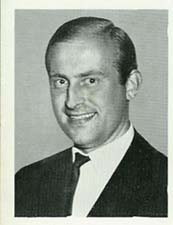
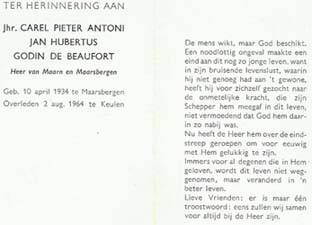
Carel's death announcement.
The procession followed a route through the estate, passing the barns where his cars were stored, before moving into the forest. There, his coffin, helmet, family arms, some rings, a bracelet, his watch and the logos of the BRDC and the Automobile Club of South Africa which he worn on his racing overall and blazer were set into the Beaufort family grave. Count Carel Pieter Antoni Jan Hubertus Godin de Beaufort was buried at the age of 30. On the family grave is written: La vertu est un beau fort. Virtue is a beautiful fortress.

The family's thank you letter.
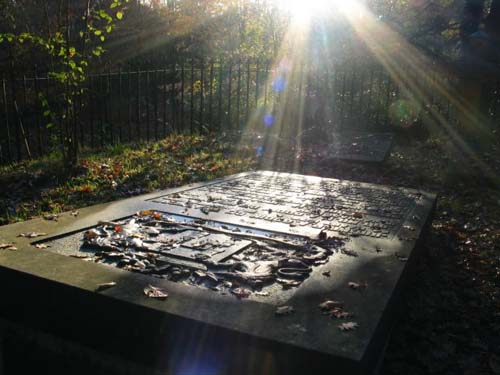
Carel's tombstone.
